Do you have May 25, 2018, marked down on your calendar? If not, you may be overlooking a momentous event that will completely change the way customer data is handled. For those not in the know, we're referring to the effective start date of the European Union's General Data Protection Regulation (GDPR).
GDPR will have a long-reaching effect on business operations by establishing new, comprehensive rules for gathering, storing and leveraging consumer data. With a long list of requirements and punitive penalties for violators, GDPR compliance should be at the top of every business's to-do list, regardless if they operate outside the EU or not. In this two-part guide, we'll cover what you need to know and what steps to take stay compliant.
What is GDPR?
Many industries like healthcare and financial services are no strangers to data regulations, but GDPR has taken requirements to another level. The goal of GDPR is to improve the security and privacy of personally identifiable information (PII) in the EU by placing tighter restrictions on data collection and management. GDPR also provides European consumers with more control over their own data, giving them clearer visibility into companies' data collection processes as well as the ability to opt out of said programs whenever they please.
"The goal of GDPR is to improve the security and privacy of PII."
How GDPR affects US-based businesses
Although GDPR strictly covers consumers who reside within the EU, that doesn't mean it only applies to European companies. The new regulations feature an increased territorial scope that outpaces any other data privacy guidelines in the world (besides China). Any business that processes PII belonging to EU residents must comply with GDPR, regardless of where their servers are located.
For organizations that have crafted data-driven customer engagement strategies, they will likely need to go back to the drawing board to account for these regulations. Ignoring GDPR is not an option, as it will create a great deal of risk.
 GDPR will affect businesses outside of the European Union.
GDPR will affect businesses outside of the European Union.Penalties for noncompliance are steep
GDPR features some of the most expensive fines for regulatory violations the world has ever seen. A single misstep could cost a business as much as $24 million or 4 percent of its annual global turnover. While those figures are at the high end, the EU is sending a clear message that companies that fail to adhere to data privacy and security best practices will be severely punished.
GDPR is a very real concern for U.S.-based businesses, and that May 25 deadline is inching closer and closer. There's still time to get your ducks in order, however, so stay tuned for Part 2 of this series, where we'll break down how to comply with GDPR's key requirements.


Leave a comment!
You must be logged in to post a comment.